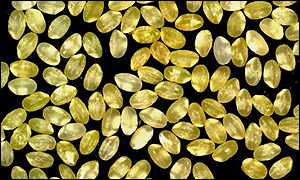*This page was produced by Ashley Cain as part of an assignment for an undergraduate course at Davidson College*
The Development of Golden Rice

Permission Pending from BBC News Online, 2000
Each year vitamin A deficiency leads to blindness in 1/4 million people (Burkhardt et al., 1997).. These deficiencies also lead to an increased susceptibility to childhood illnesses. Vitamin A deficiencies are widespread among undeveloped countries where rice, a vitamin A deficient food, is a staple food source (Burkhardt et al., 1997). In the early 1990s Dr. Ingo Potrykus of the Swiss Federal Institute of Technology began his struggle to create a genetically modified rice grain which would produce its own vitamin A (Potrykus, 2000). Seven years and $2.6 million later, Dr. Xudong Ye, a member of Potrykus' lab, presented his grains of golden rice to the world in 2000 (Nash, 2000). This golden rice contained genes from a daffodil and bacteria that caused the rice to produce its own vitamin A. Although this rice seemed to be the perfect genetically modified organism (GMO), many critics are against its use in undeveloped and developed countries. The development of this unique GMO represented an advancement in biotechnology and at the same time created a firestorm of controversy.